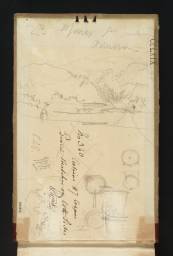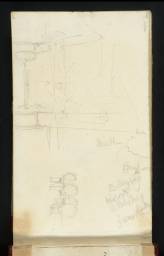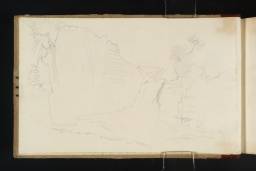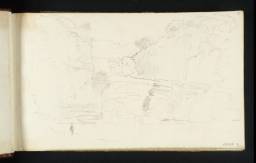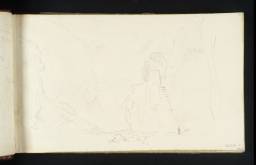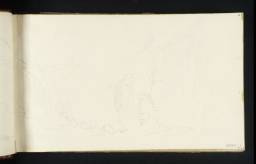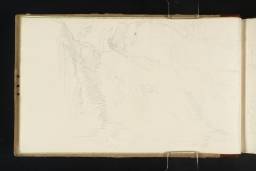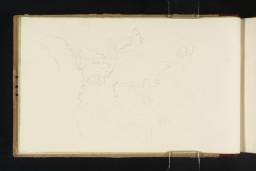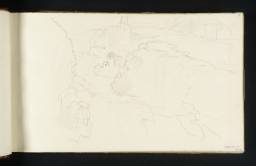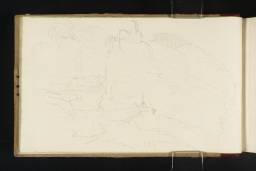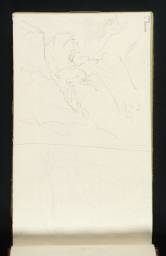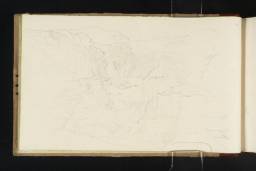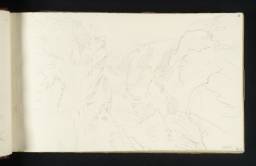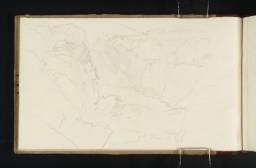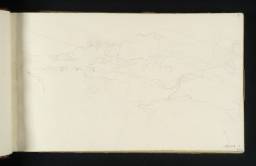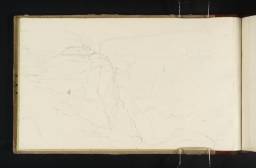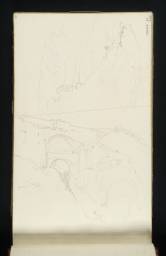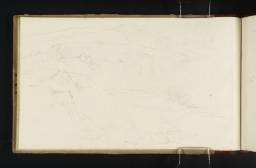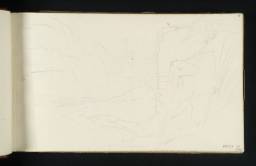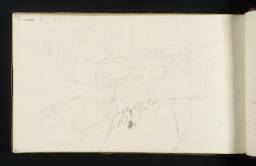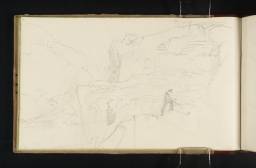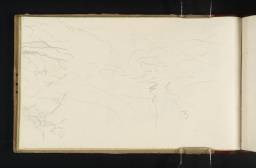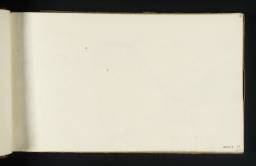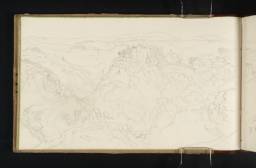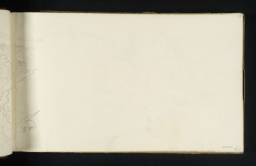Turner Bequest CCLXIX
Sketchbook bound in cardboard with brown leather spine and a broken brass clasp. Spine replaced with modern rebinding. Blindstamped on the front cover with the Turner Bequest stamp at the upper left on the leather spine, and stamped in black ‘CCLXIX’ at the top right. Back cover (D41049) faintly inscribed in pencil by Turner ‘22 11 | 5 6 | 6 | 2 | 1’ lower centre inverted, and stamped in black ‘CCLXIX’ top left.
91 leaves of white wove watermarked ‘J JELLYMAN | 1828’ made by Joseph Jellyman. The sketchbook was made by the same maker as the Minstrelsy of the Scottish Border (Tate D25762–D25928; D41077–D41078 complete; Turner Bequest CCLXVI) and the Abbotsford (Tate D25929–D26095; D40995–D40996 complete group; Turner Bequest CCLXVII) sketchbooks.
Approximate paper size 113 x 190 mm
Numbered ‘No.340’ as part of the Turner Schedule in 1854 and endorsed by the executors of the Turner Bequest on the inside back cover (D41047).
91 leaves of white wove watermarked ‘J JELLYMAN | 1828’ made by Joseph Jellyman. The sketchbook was made by the same maker as the Minstrelsy of the Scottish Border (Tate D25762–D25928; D41077–D41078 complete; Turner Bequest CCLXVI) and the Abbotsford (Tate D25929–D26095; D40995–D40996 complete group; Turner Bequest CCLXVII) sketchbooks.
Approximate paper size 113 x 190 mm
Numbered ‘No.340’ as part of the Turner Schedule in 1854 and endorsed by the executors of the Turner Bequest on the inside back cover (D41047).
Accepted by the nation as part of the Turner Bequest 1856
Exhibition history
References
There has been uncertainty in the past about the correct dating of the Stirling and Edinburgh sketchbook. A.J. Finberg, who was unaware of Turner’s trip to Scotland in 1834, dated this book to 1831;1 a suggestion followed by most subsequent writers.2 The book was first dated to 1834 by Gerald Finley who matched some of the sketches to events described in Robert Cadell’s diary.3 David Wallace-Hadrill and Janet Carolan, despite their suggestion that the book was used on both tours, noticed that sketches of Bothwell must be dated to 1834 as they include a church tower that was not built until 1833 (folio 31; D26319).4 This led them to the conclusion that the sketches of the Falls of Clyde must also belong to 1834, and that the sketches of Glasgow could have been made in either year. The tentative nature of their conclusion was expressed in their question, ‘how far in book CCLXIX does the 1834 element extend?’5 The question continued to plague Wallace-Hadrill who later found evidence that the Glasgow visit must have taken place in 1834 as the Bridge of Sighs (Tate D26391; Turner Bequest CCLXIX 69a) was not built until 1833.6 In an unpublished manuscript about the itinerary of the 1834 tour he concluded that the sites he had previously attributed to 1831 were in fact sketched in 1834.7
The sketchbook can now be firmly dated to Turner’s 1834 tour of Scotland and placed into proper sequence alongside the other two sketchbooks he used on that occasion: Loch Ard (Tate D26667–D26747 complete; Turner Bequest CCLXXII) and Edinburgh (Tate D26096–D26258 complete; Turner Bequest CCLXVIII). The tour was undertaken at the behest of the publisher Robert Cadell who had commissioned Turner to prepare illustrations to various works by and about Sir Walter Scott; see Tour of Scotland for Scott’s Prose Works 1834 Tour Introduction.
This was the first sketchbook that Turner opened in Scotland, which was not until three days after his arrival at Edinburgh on 15 September. Setting off by coach from Edinburgh on the morning of 18 September, Turner arrived at the town of Lanark and headed south to the Falls of Clyde. His sketches suggest that he started at Bonnington Linn, and then went to Corra Linn, before returning to Bonnington and then Corra again (folio 1 verso; D26260). He seems to have been particularly interested in Corra Castle which he may have sketched from one or both of the suggested viewing points: ‘a semicircular seat [...] upon the verge of the cliff opposite the Fall, where he will have the best view of this fascinating waterfall’ and from Bonnington Pavilion, built by Sir James Carmichael in 1708 and at one time containing a wall of mirrors which reflected the view and framed it in an appropriately picturesque manner. He had been to the falls before in 1801 when he imagined them as the setting for Mark Akenside’s poem Hymn to the Naiads: The Fall of the Clyde, Lanarkshire: Noon – Vide Akensid’s Hymn to the Naiads, exhibited 1802 (Walker Art Gallery, National Museums Liverpool).8 In 1834 Turner had a different work of literature in mind: Walter Scott’s novel, Old Mortality (1816), which is partially set in the area.9 This must therefore have been the first subject that Robert Cadell had asked Turner to sketch as a potential illustration to Scott.
From the falls Turner headed north-west up the Clyde to Milton Lockhart, the house of Scott’s future biographer John Gibson Lockhart near Rosebank. Lockhart’s diary shows that Turner dined at the house that night, and he may have stayed there as the next morning the writer and artist went together to Craignethan Castle,10 which was to be another illustration to Old Mortality as the model or stand-in for the imaginary Tillietudlem Castle (see folio 14 verso; D26286). Perhaps heading off on his own, Turner proceeded to the village of Douglas, where he sketched the ruin of Old Douglas Castle and the new mansion that stood nearby, before drawing the interior and exterior of St Bride’s Chapel. These sites feature as locations in Castle Dangerous (1831) so were presumably visited for illustration to that novel by Scott (see folio 21 verso; D26300). From Douglas Turner headed north to the town of Bothwell to draw the Castle and bridge for another possible illustration to Old Mortality, which deals with the battle of Bothwell Bridge (see folio 26; D26309).
Turner’s next destination may have been Stirling. On the way he stopped at St Ninian’s to the south of the city, from where he sketched the distant Stirling Castle with St Ninian’s church in the foreground (folio 45 verso; D26344). He also took the opportunity to sketch the battlefield of Bannockburn from near the village of Borestone (folio 46 verso; D26346). This may have been considered as a possible illustration to the first volume of Scott’s Tales of a Grandfather (1828), which included an account of the battle (chapter 10). Arriving at Stirling, Turner made numerous sketches of the castle, as well as the church and the ruins of the Mars Works (see folio 44 verso; D26342). While the city has relevance for Scott’s novel, Waverley (1814), Turner’s main object may have been to gather sketches for an illustration to volume 23 of Scott’s Tales of a Grandfather: Stirling circa 1834–5 (Glasgow Museums).11 Turner headed north to Dunblane where he sketched the cathedral (folio 57; D26367), before heading west to the town of Doune to sketch the castle as a possible illustration to Waverley (folio 52 verso; D26358).
Callander was Turner’s next stop and his base for excursions to the Trossachs. At this point the Loch Ard sketchbook became his principal sketchbook, though there are a few sketches of Callander and nearby sites in the present book (see folio 35; D26327). Turner passed through Doune and Dunblane again on his journey east. His next sketches were made at the town of Dollar where he stopped to visit Castle Campbell (folio 70 verso; D26393). Continuing east Turner sketched Rumbling Bridge (folio 43; D26339) on his way to Kinross. He here visited Loch Leven, sketching the castle (folio 73; D26398) for an illustration to Scott’s novel The Abbot. This was one of the few illustrations that Turner actually got the opportunity to make to Scott’s novels, though the commission came not from Cadell, but for Fisher and Co.’s Landscape – Historical Illustrations of Scotland and the Waverley Novels: Lochleven Castle circa 1835 (whereabouts unknown).12
The final part of Turner’s ten-day tour was to Perth; this is recorded in the Loch Ard sketchbook. Back in Edinburgh on 29 September Turner picked up the Stirling and Edinburgh sketchbook once again for a sketch of 39 Castle Street, the former home of Sir Walter Scott (folio 40 verso: D26336). The sketch formed the basis of a watercolour: No.39 Castle Street, Edinburgh circa 1836 (Pierpont Morgan Library, New York),13 which was engraved as the title vignette for volume IV of J.G. Lockhart, Memoirs of the Life of Sir Walter Scott, 1839.14 He now opened the Edinburgh sketchbook for the first time, using it during a two-day tour around Peebles, St Mary’s Loch, Selkirk and Melrose. His next sketches in the Stirling and Edinburgh book were made on 1 October when he drew Edinburgh from St Anthony’s Chapel on Arthur’s Seat (folio 89 verso; D26431). These sketches were used as the basis of Turner’s illustration to the first volume of Tales of a Grandfather: Edinburgh from St Anthony’s Chapel circa 1834 (whereabouts unknown).15 His final sketches are also of Edinburgh, this time from Calton Hill and were probably made on 4 October which is likely to have been his final day in the city before setting off for London by sea (folio 79 verso; D26411).
Crawford 1936, pp.25–9; Gage 1969, pp.41, 126, 232 note 11, 254 note 250; Butlin, Wilton and Gage 1974, p.126 no.451; Cormack 1975, p.51 note 3; Butlin and Joll 1984, p.300 under cat.510; Wilton 1987, p.204; Wilton 2006, p.239; Warrell 1999, pp.43–4, 255 note 156.
Corra Linn was chosen for the illustration to The Tale of Old Mortality, by Scott’s publisher, Robert Cadell, for his ‘Abbotsford edition’ of Sir Walter Scott’s Waverley Novels. Waverley Novels [Abbotsford edition], vol.II, Edinburgh 1843, facing title page, Edward Goodall after Clarkson Stanfield, ‘Corra-Linn, near Lanark’, engraving.
Technical notes
How to cite
Thomas Ardill, ‘Stirling and Edinburgh sketchbook 1834’, sketchbook, March 2011, in David Blayney Brown (ed.), J.M.W. Turner: Sketchbooks, Drawings and Watercolours, Tate Research Publication, December 2012, https://www

